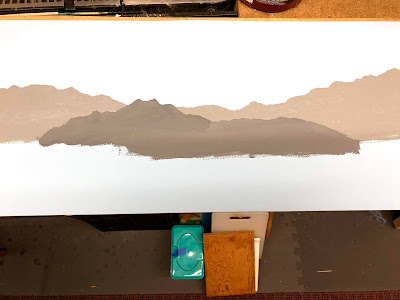The N scale project currently underway is basically to flatten more areas on the layout, to allow more industries and spurs to improve operational fun. Now that I have all the demolition and construction tools mobilized, it's difficult to stop. Here are some photos of additional areas of the N scale layout that are getting "flattened":
This area of "Everett" is a gentle slope that, if flattened, could be a factory with railroad spurs.
Using a Dremel "Multi-Max MM35" with a front-facing saw-blade attachment, I was able to easily rip a hole in the plaster and cardboard scenery and remove it.
This left a gaping hole in the layout, so I screwed in a plywood splice place from underneath the layout (to make future changes possible if needed) and cut another piece of plywood to completely cover the hole
Then it was a matter of inserting foam trim pieces using a low-temperature hot glue gun. Once these are trimmed and the whole area is covered with sheet cork, painted and textured, you'll never know it wasn't always there, ready for development!
A note on making revisions with plywood scraps. When I built this layout in 1980, 1/2" plywood was exactly that. 1/2". 40 years later, "1/2"" plywood is actually 7/16" thick. Which is great for the profits of plywood companies, but is not great for model railroad remodelers. This means that I now have an annoying 1/16" lip between plywood pieces to somehow smooth over. I suppose I could have used shims to prevent this, but as usual I'm pushing myself to get the project done, not to get it perfect. I like to preach the mantra "no short-cuts", but I don't always practice what I preach.
Now let's turn to the "Mukilteo" area of the layout. I originally built this area using Midwest cork roadbed nailed down to plywood, with Atlas N scale code 80 track nailed on top of it. Here's a picture of the area after I removed the factories, but not the track.
The layout of this track made sense to me at the time (40 years ago), but I was never able to make good use of the area, especially with that huge ballast shoulder created by the cork roadbed in the middle of an industrial area. Now I understand that I should have covered the whole area with cork sheet and then it would have been easier to add roads and make adjustments to track arrangements without messy scenery alterations.
The advantage of using roadbed and track nails on the original layout was that it took me all of 10 minutes to easily remove those two tracks and roadbed, clearing the way for removing any unneeded plaster from the plywood surface.
These two photos show the area after applying the "multi-max" tool. This time I plan to apply sheet cork and some more prototype-based industries. For example, there can be a long spur to represent the Boeing factory at Paine Field, and two tracks to represent the Standard Oil transloading facility that existed along the Puget Sound shore and was served by the local train called the "Oiler".
One last comment on the lower photo - you can see some shaved-off scenery and bare cork roadbed in the lower left-hand corner. This track now comes from an area of the main yard which I've called "Burlington" and represents the "Concrete Branch" which ran east into the Cascade Mountains. I am planning to extend this track an additional 4' so that it can be set up to actually operate as a branch line. In the intervening 40 years, I've become interested in the various prototype trains that operated in this area, which leads to track changes to improve operations.




































